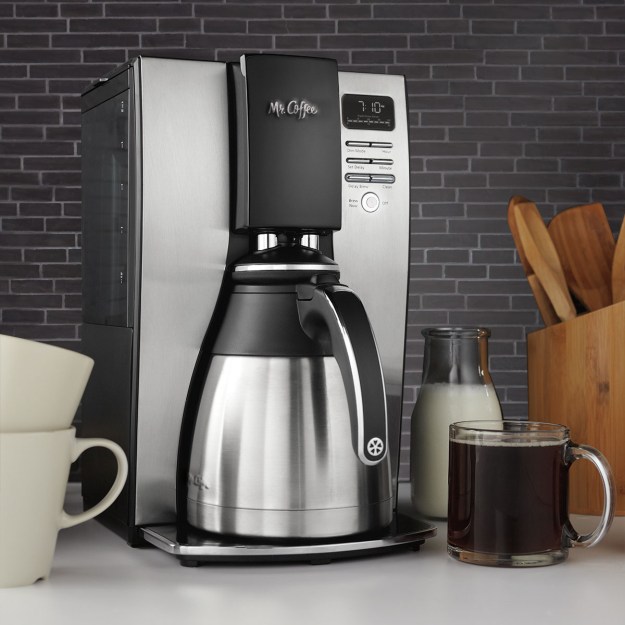There’s just no telling how unbearable life would be without that first cup of coffee in the morning. For many of us, it’s an absolute necessity, which is why there are hundreds of different coffee makers to choose from. Some are basic pour-and-go models and others more advanced and tailor-made for specific blends and flavors. We rely on our coffee makers to produce a nice, hot cup of coffee that’s just right. We trust our coffee makers, and we don’t expect them to make a tainted cup of expensive coffee that tastes terrible.

How clean is the coffee that comes out of your machine? That depends. A better question is how clean is your coffee maker? Some people think because the coffee itself is hot, that it kills all the bacteria and their cup of joe is automatically sanitary. But if you don’t clean your coffee maker, you could actually be drinking coffee that’s not exactly appetizing. Your machine could even contain mold or other nasty bacteria.
Moist and wet environments are ideal places for yeast and mold to grow. A study by NSF International found that 50 percent of households had yeast and mold in the reservoir of their coffee maker. When CBS News swabbed 11 household coffee makers, they found 11 different types of bacteria, including pseudomonas aeruginosa (a bacteria that grows in standing water) and enterobacter bacteria (a coliform bacteria that’s present in the human colon).
Grossed out yet? If cleaning your coffee machine isn’t a part of your chores, you may want to make it a part of your cleaning regimen. Here’s how to properly clean your standard-drip coffee machine.

What you’ll need
You don’t need anything special to clean your coffee machine, just a few items you probably already have around the house.
- Vinegar
- Distilled water
- Baking soda
- Dish soap
- A clean sponge or gentle scrub brush
- A clean cloth
Step 1: Remove the coffee maker’s filter
Start off by removing your machine’s reusable filter (if applicable). Then, soak the filter in a solution of distilled water and a squirt of mild dish soap for 20 minutes. Then, give it a good rinse under water to remove any soap residue. After you’ve rinsed it thoroughly, leave the filter out on a drying rack, and allow it to dry completely.
Step 2: Create a cleaning solution and run it through your coffee machine
Mix one cup of vinegar with one cup of distilled water to create a cleaning solution. For smaller coffee makers, you can use one-half cup of vinegar and one-half cup of water. Pour this solution into the water tank, and let it sit for about 20 minutes. This will help clean some of the funk that’s sitting in the bottom of the water tank.
After the 20 minute time period passes, turn on the coffee machine and brew the vinegar and water solution through your machine. Once it brews through into the pot, swirl the hot vinegar and water solution around your coffee pot, and then discard the solution.
Brew two cups of distilled water in your machine to help eliminate any vinegar residue. Mix the hot water in the coffee pot, and then drain the water out of it. Do this process again and again until the vinegar smell completely goes away.
Step 3: Clean your machine’s exterior
Wipe down the outside surface of the machine using a clean sponge or disinfecting wipes, baking soda, and distilled water. You can also use dish soap to eliminate any coffee discolorations. After you do this, rub your machine with a cloth and water to clear off any remaining baking soda or soap deposits. After you’ve finished washing off the outside of the machine, keep the lid off of the water tank. Separate the cover from the coffee pot and let your coffee maker dry completely.
How often to clean your coffee machine and other tips
It’s always best to deep clean your coffee maker by putting the previously mentioned steps above into action at least one time each month. It’s also a good idea to refer to your machine’s manufacturer manual for further guidance on how to effectively clean your specific coffee machine. Another thing you can do regularly is remove the filter and clean the interior of your coffee pot with mild dish soap and water after each use. We’ve compiled a list of tips and tricks that will help keep your coffee maker as clean and sanitary as possible:
- It’s generally not a good idea to place your coffee pot or any other parts of the machine in the dishwasher.
- When your machine is empty and you’re not using it, leave the lids off of both the water reservoir and the coffee pot. This allows the interior to dry completely, and it helps reduce mold and bacteria growth. Many types of mold and bacteria thrive in damp environments.
- Avoid using harsh cleaners like bleach in your coffee machine. Even if you rinse it thoroughly, you may still be left with residue. Plus, you don’t want to damage your machine. It’s best to use a food safe cleaner on the interior of your machine.
- Distilled water is ideal for cleaning your coffee machine because it doesn’t leave behind impurities or water stains.
- This guide includes instructions for cleaning a standard drip coffee maker with a pot. For detailed instructions on how to clean a Keurig machine, check out our Keurig cleaning guide.
Editors' Recommendations
- Best coffee maker deals: Cuisinart, Ninja, Mr. Coffee starting at $20
- Best Keurig deals: Get perfect coffee at home every time for $60
- Cuisinart vs. Keurig: Smart coffee makers compared
- What is a smart coffee maker?
- How do I clean my Dyson cordless filter?




